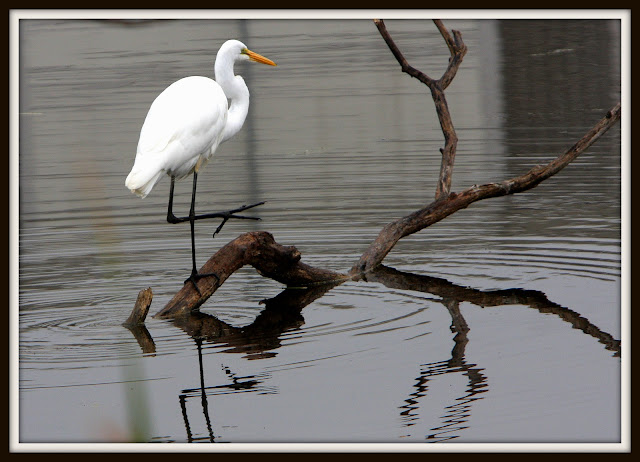This is white. Pure white. On a dark day over gray water. This Great Egret is alert; spotting the target, and ready to strike.
Notice the lores, they are slightly greenish near the eyes.
The relatively thin bill is very slightly downcurved.
This is a tall, stately, slender white heron with a yellow bill, and a long neck.
Foraging birds stand tall and walk slowly.
Size: 35 - 41 " (89-104cm) tall. Wingspan = 51 - 55 " (1.4-1.5 m) Weight = 1.9 lbs. ((870g)
When feeding, it assumes an eager, forward-leaning pose, with its neck extended.
The Great Egret has black legs and feet. Whereas the Snowy Egret has black legs and yellow feet, (it's quite a sight) and is much smaller.
I love this action shot. It's so sure-footed, climbing its way up this submerged limb. See its toes wrapped around the branch for better balance? The right foot is ready for the next step and grip. He displays excellent dexterity. Could you climb up a wet log, without looking at your feet? Can you even wrap your toes around a thick branch?
Food:
Small fish, frogs, and crayfish in shallow water. Occasionally snakes, salamanders, lizards, and large insects like grasshoppers.
He has a small fish clamped in his bill up there.
Here, he works to subdue the fish, and toss it down his throat.
Habitat: Freshwater and saltwater marshes, marshy ponds and tidal flats.
Nesting:
Nests in colonies, often with other species of herons. Lays 3-5 pale, blue-green eggs on a platform of sticks in trees and bushes.
Range:
Pink = Summer Light Blue = Winter Dark Blue/Purple = Year-round
Voice:
A very deep, low, gravelly "kroow", or a grating, unmusical, "karrrr". Also a low, hoarse croak, or a "cuk, cuk, cuk".
Click on Cornell Labs to hear several calls.
Other:
Formerly known as the American Egret, Common Egret, Large Egret, White Egret, Great White Egret, and Great White Heron. This bird's official name is now: "Great Egret".
It has recovered from historic persecution by plume hunters of previous centuries.
Look for them in a place like this. Once you see one, you will never forget your time spent with the Great Egret.
(Click on photos to enlarge)
Great Egret: (Ardea alba)
Photo Location: Cascade Township, (Cascade) Kent County, Michigan
Resources:
Peterson Field Guide to Birds of North America (Peterson) c 2008
Sibley Guide to Birds - David Allen Sibley (Sibley) c 2000
National Audubon Society Field Guide to North American Birds (Audubon) c 1994










































